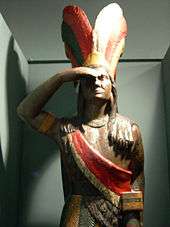Cigar store Indian


The cigar store Indian or wooden Indian is an advertisement figure, in the likeness of a Native American, used to represent tobacconists. The figures are often three-dimensional wooden sculptures several feet tall – up to life-sized. They are still occasionally used for their original advertising purpose, but are more often seen as decorations or advertising collectibles, with some pieces drawing sales prices of up to $500,000. People within the Native American community often view such likenesses as a caricature or as depictions that perpetuate stereotypes, drawing an analogy to the African-American lawn jockey.
History
Because of the general illiteracy of the populace, early store owners used descriptive emblems or figures to advertise their shops' wares; for example, barber poles advertise barber shops, show globes advertised apothecaries and the three gold balls represent pawn shops. American Indians and tobacco had always been associated because American Indians introduced tobacco to Europeans,[1] and the depiction of native people on smoke-shop signs was almost inevitable. As early as the 17th century, European tobacconists used figures of American Indians to advertise their shops.
Because European carvers had never seen a Native American, these early cigar-store "Indians" looked more like black slaves with feathered headdresses and other fanciful, exotic features. These carvings were called "Black Boys" or "Virginians" in the trade. Eventually, the European cigar-store figure began to take on a more "authentic" yet highly stylized native visage, and by the time the smoke-shop figure arrived in the Americas in the late 18th century,[2] it had become thoroughly "Indian."
Today
The cigar store Indian became less common in the 20th century for a variety of reasons.[3] Sidewalk-obstruction laws dating as far back as 1911 were one cause.[4] Later issues included higher manufacturing costs, restrictions on tobacco advertising, and increased racial sensitivity, all of which relegated the figures to museums and antique shops.[5] Many also were destroyed during scrap drives for metal and wood during World War I and World War II. Cigar store figures are now viewed as folk art and some models have become collector's items, drawing prices up to $500,000.[4] Modern replicas of cigar store Indians are still made for sale, some as cheap as $600.[4]
People within the Native American community often view such likenesses as offensive for several reasons. Some objections are because they are used to promote tobacco use as recreational instead of ceremonial.[4] Other objections are that they perpetuate a "noble savage" or "Indian princess" caricature or inauthentic stereotypes of Native people,[6] implying that modern individuals "are still living in tepees, that we still wear war bonnets and beads."[7] drawing parallels to the African-American lawn jockey.[8]
References
- ↑ The Freelance Star (Sep 11, 1982) Cigar Store Indian was Early Advertising Sign Retrieved 2010 May 3
- ↑ The Milwaukee Journal (Mar 17, 1968) Cigar Store Indian Started in England Retrieved 2010 May 3
- ↑ Lewiston Evening Journal (Nov 4, 1944) Once Familiar Cigar Store Indian No Longer Designates Tobacco Shop Retrieved 2010 May 3
- 1 2 3 4 Schuman, Evan (Winter 2004–2005). "From the sidewalk to Sotheby's, The Cigar Store Indian is a piece of American tobacco history" (PDF). Cigar Magazine. Retrieved August 10, 2015.
- ↑ Eugene Register (Sep 17, 1952) Cigar Store Indian Getting New Life Retrieved 2010 May 3
- ↑ Behnken, Brian D; Smithers, Gregory D (2015). Racism in American Popular Media: From Aunt Jemima to the Frito Bandito. ABC-CLIO. ISBN 9781440829772.
- ↑ "Indian Official Calls for City to Curb Racist Sales Displays". Los Angeles Times. Retrieved August 11, 2015.
- ↑ The Milwaukee Journal (Dec 11, 1948) First Cigar Store Indian Wasn't an Indian at all Retrieved 2010 May 3
External links
![]() Media related to Cigar store Indian at Wikimedia Commons
Media related to Cigar store Indian at Wikimedia Commons